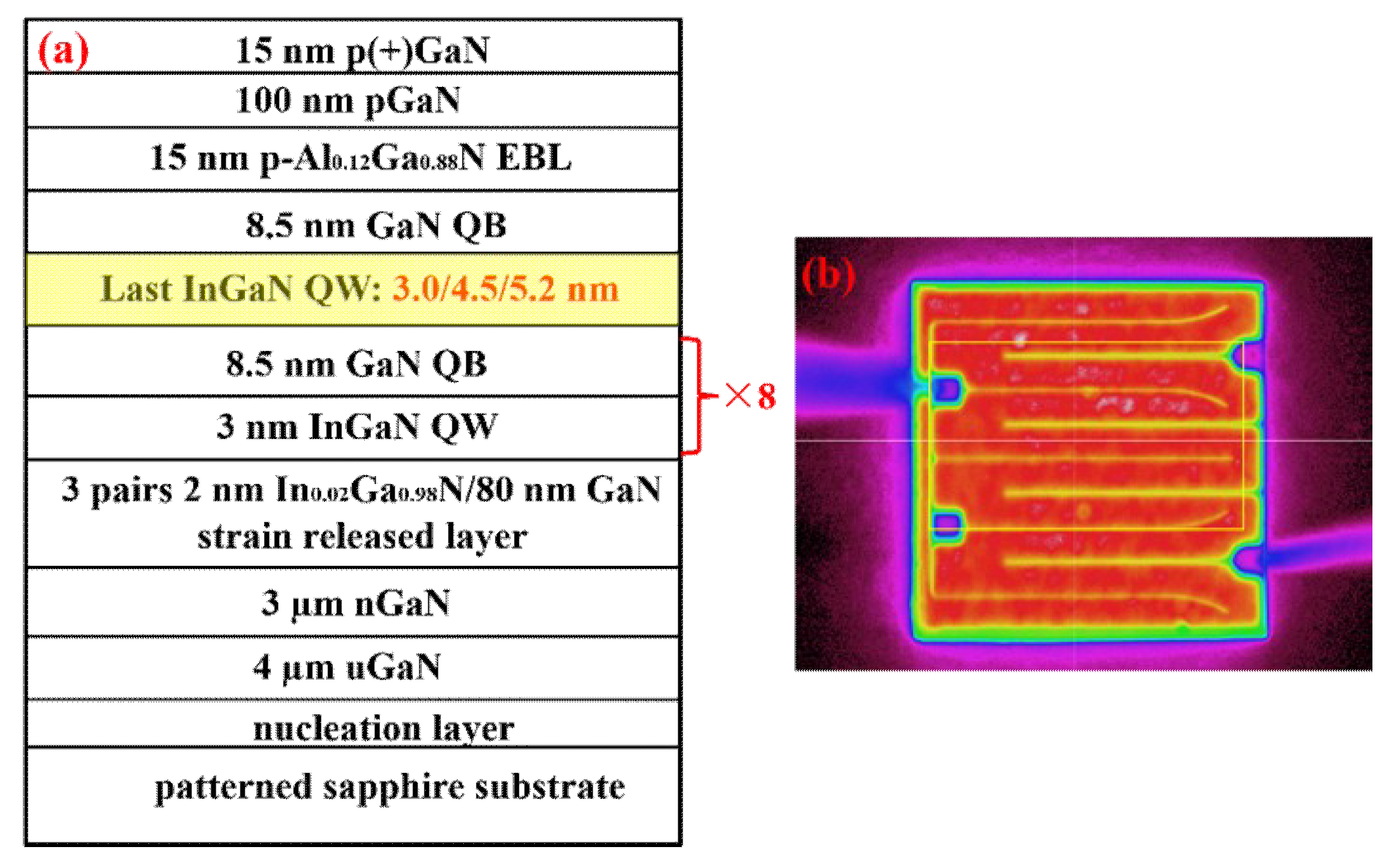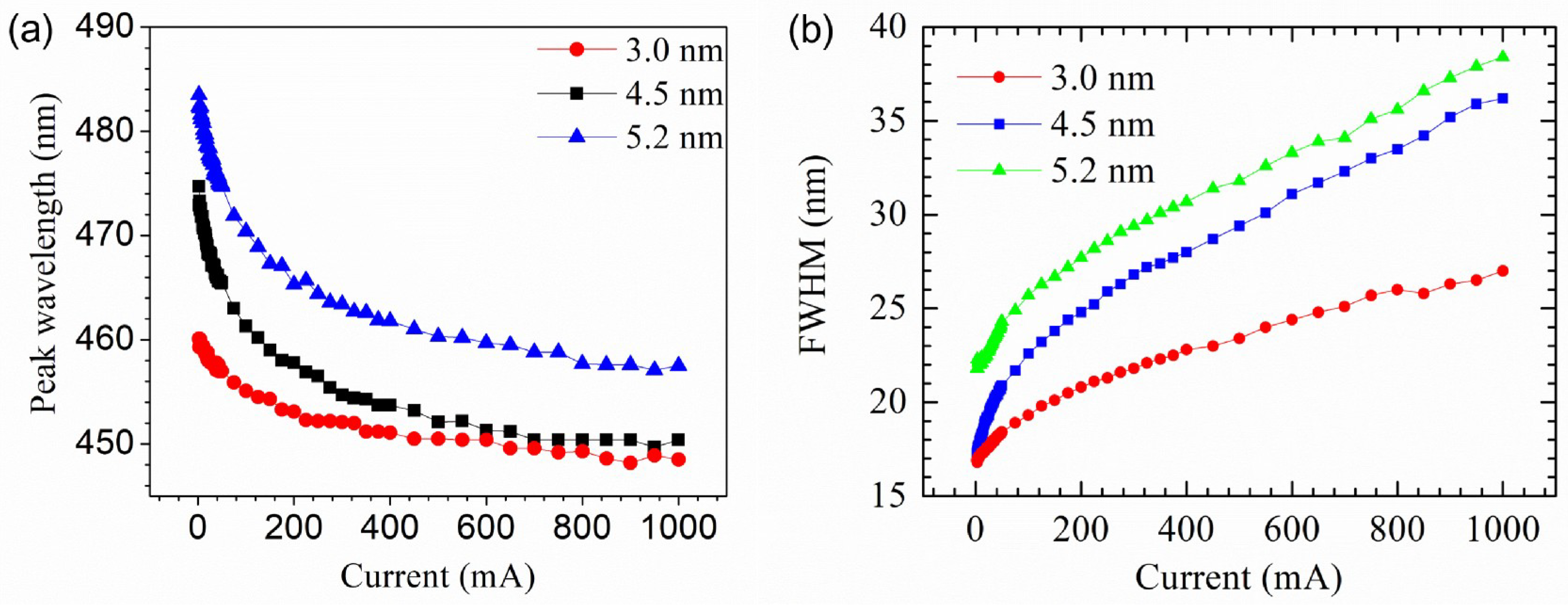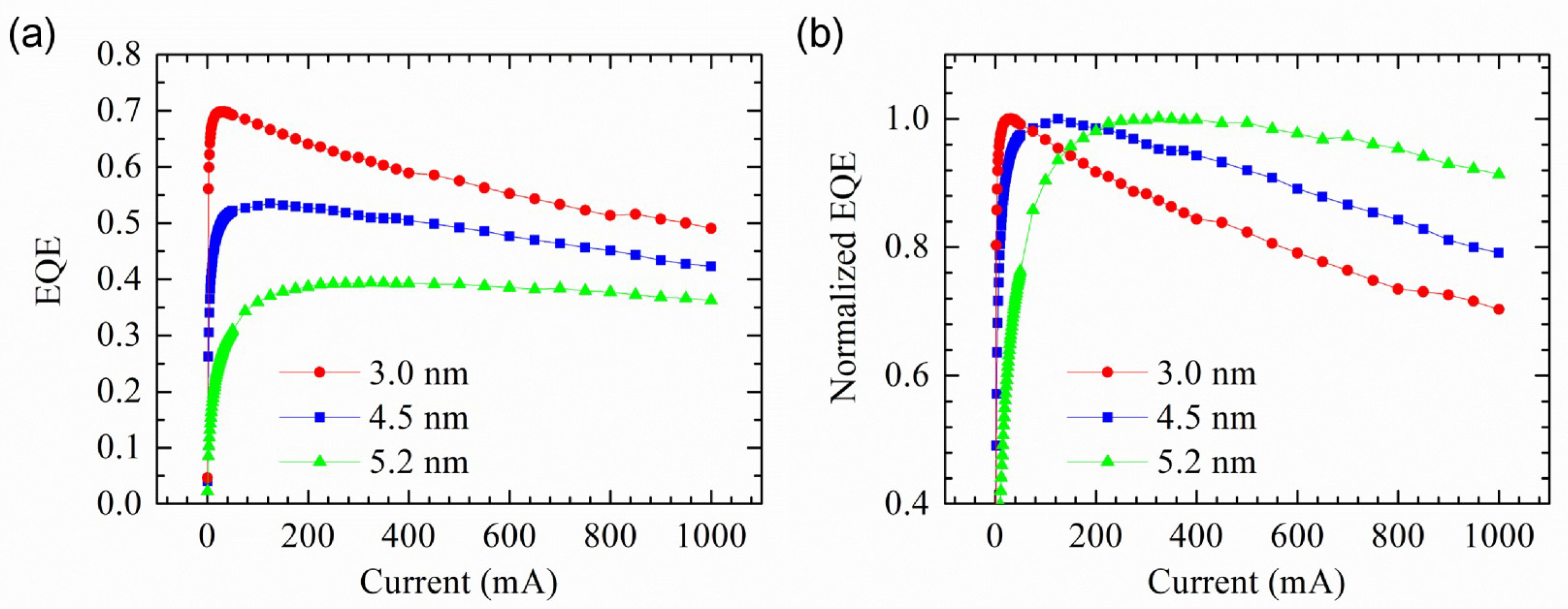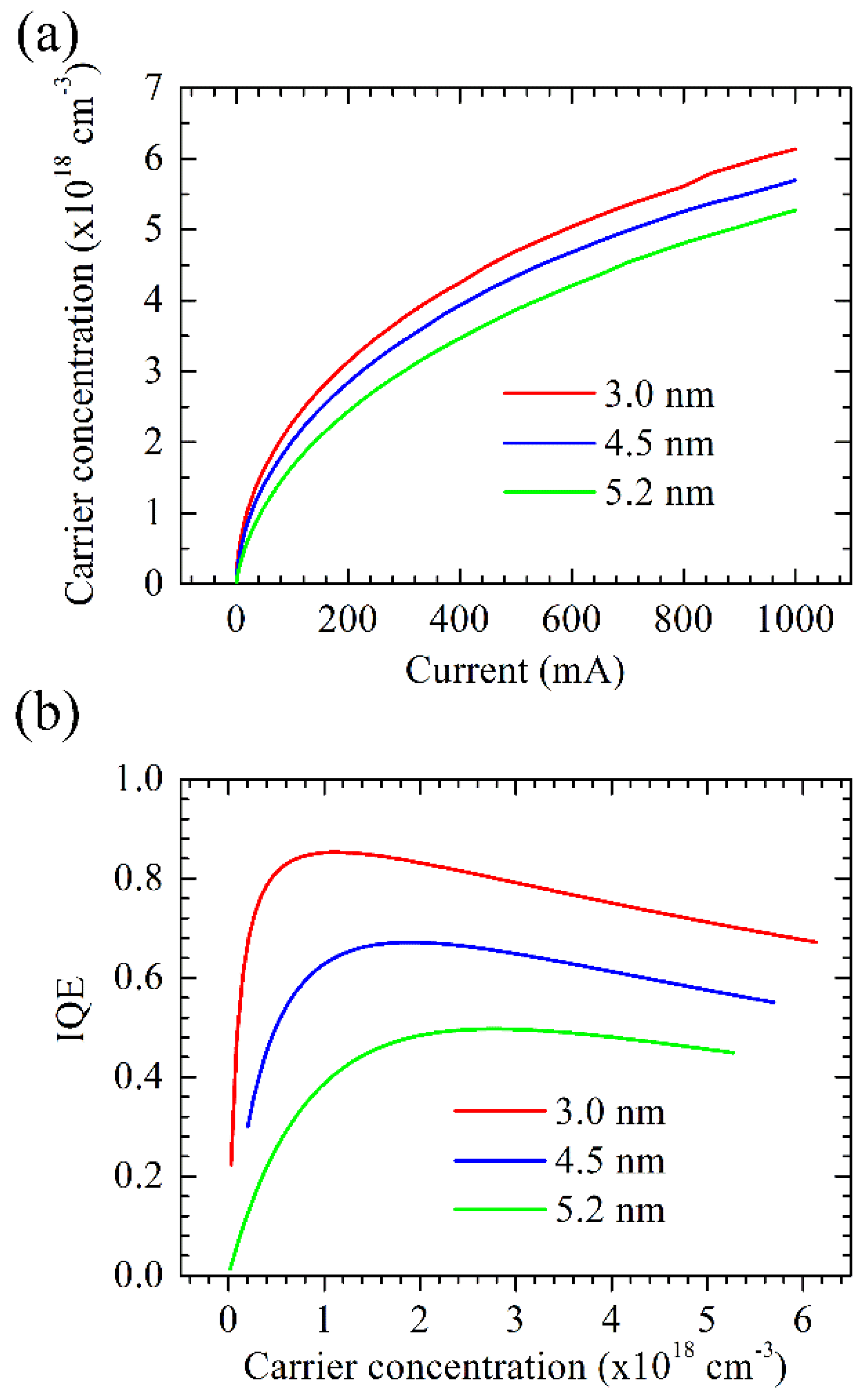Toward Ultra-Low Efficiency Droop in C-Plane Polar InGaN Light-Emitting Diodes by Reducing Carrier Density with a Wide InGaN Last Quantum Well
Abstract
1. Introduction
2. Materials and Methods
3. Results and Discussion
4. Conclusions
Author Contributions
Funding
Conflicts of Interest
References
- Nakamura, S.; Senoh, M.; Iwasa, N.; Nagahama, S.I. High-brightness InGaN blue, green and yellow light-emitting diodes with quantum well structures. Jpn. J. Appl. Phys. 1995, 34, 797. [Google Scholar] [CrossRef]
- Lin, W.; Li, S.; Kang, J. Near-ultraviolet light emitting diodes using strained ultrathin InN/GaN quantum well grown by metal organic vapor phase epitaxy. J. Appl. Phys. Lett. 2010, 96, 101115. [Google Scholar] [CrossRef]
- Li, H.; Li, P.; Kang, J.; Li, Z.; Zhang, Y.; Li, Z.; Li, J.; Yi, X.; Wang, G. Quantum efficiency enhancement of 530 nm InGaN green light-emitting diodes with shallow quantum well. Appl. Phys. Express 2013, 6, 052102. [Google Scholar] [CrossRef]
- Kim, M.H.; Schubert, M.F.; Dai, Q.; Kim, J.K.; Schubert, E.F.; Piprek, J.; Park, Y. Origin of efficiency droop in GaN-based light-emitting diodes. Appl. Phys. Lett. 2007, 91, 183507. [Google Scholar] [CrossRef]
- Shen, Y.C.; Mueller, G.O.; Watanabe, S.; Gardner, N.F.; Munkholm, A.; Krames, M.R. Auger recombination in InGaN measured by photoluminescence. Appl. Phys. Lett. 2007, 91, 141101. [Google Scholar] [CrossRef]
- Delaney, K.T.; Rinke, P.; Van de Walle, C.G. Auger recombination rates in nitrides from first principles. Appl. Phys. Lett. 2009, 94, 91109. [Google Scholar] [CrossRef]
- David, A.; Grundmann, M.J. Droop in InGaN light-emitting diodes: A differential carrier lifetime analysis. Appl. Phys. Lett. 2010, 96, 103504. [Google Scholar] [CrossRef]
- Schubert, M.F.; Chhajed, S.; Kim, J.K.; Schubert, E.F.; Koleske, D.D.; Crawford, M.H.; Banas, M.A. Effect of dislocation density on efficiency droop in InGaN/GaN light-emitting diodes. Appl. Phys. Lett. 2007, 91, 231114. [Google Scholar] [CrossRef]
- Schubert, M.F.; Xu, J.; Kim, J.K.; Schubert, E.F.; Kim, M.H.; Yoon, S.S.; Lee, M.; Sone, C.; Sakong, T. Polarization-matched GaInN/AlGaInN multi-quantum-well light-emitting diodes with reduced efficiency droop. Appl. Phys. Lett. 2008, 93, 041102. [Google Scholar] [CrossRef]
- Kang, J.; Li, H.; Li, Z.; Liu, Z.; Ma, P.; Yi, X.; Wang, G. Enhancing the performance of green GaN-based light-emitting diodes with graded superlattice AlGaN/GaN inserting layer. Appl. Phys. Lett. 2013, 103, 102104. [Google Scholar] [CrossRef]
- Li, H.; Kang, J.; Li, P.; Ma, J.; Wang, H.; Liang, M.; Yi, X.; Wang, G. Enhanced performance of GaN based light-emitting diodes with a low temperature p-GaN hole injection layer. Appl. Phys. Lett. 2013, 102, 011105. [Google Scholar] [CrossRef]
- Monemar, B.; Sernelius, B.E. Defect related issues in the “current roll-off” in InGaN based light emitting diodes. Appl. Phys. Lett. 2007, 91, 181103. [Google Scholar] [CrossRef]
- Yang, Y.; Cao, X.A.; Yan, C.H. Rapid efficiency roll-off in high-quality green light-emitting diodes on freestanding GaN substrates. Appl. Phys. Lett. 2009, 94, 041117. [Google Scholar] [CrossRef]
- Iveland, J.; Martinelli, L.; Peretti, J.; Speck, J.S.; Weisbuch, C. Direct measurement of Auger electrons emitted from a semiconductor light-emitting diode under electrical injection: identification of the dominant mechanism for efficiency droop. Phys. Rev. Lett. 2013, 110, 177406. [Google Scholar] [CrossRef] [PubMed]
- Verzellesi, G.; Saguatti, D.; Meneghini, M.; Bertazzi, F.; Goano, M.; Meneghesso, G.; Zanoni, E.J. Efficiency droop in InGaN/GaN blue light-emitting diodes: Physical mechanisms and remedies. Appl. Phys. 2013, 114, 071101. [Google Scholar] [CrossRef]
- Gardner, N.F.; Müller, G.O.; Shen, Y.C.; Chen, G.; Watanabe, S.; Götz, W.; Krames, M.R. Blue-emitting InGaN–GaN double-heterostructure light-emitting diodes reaching maximum quantum efficiency above 200 A/cm2. Appl. Phys. Lett. 2007, 91, 243506. [Google Scholar] [CrossRef]
- Li, Y.L.; Huang, Y.R.; Lai, Y.H. Efficiency droop behaviors of multiple-quantum-well light-emitting diodes with varying quantum well thickness. Appl. Phys. Lett. 2007, 91, 181113. [Google Scholar] [CrossRef]
- Li, Y.L.; Huang, Y.R.; Lai, Y.H. Investigation of efficiency droop behaviors of InGaN/GaN multiple-quantum-well LEDs with various well thicknesses. IEEE J. Sel. Top. Quantum Electron. 2009, 15, 1128. [Google Scholar] [CrossRef]
- Schubert, M.F.; Schubert, E.F. Effect of heterointerface polarization charges and well width upon capture and dwell time for electrons and holes above GaInN/GaN quantum wells. Appl. Phys. Lett. 2010, 96, 131102. [Google Scholar] [CrossRef]
- Pan, C.C.; Tanaka, S.; Wu, F.; Zhao, Y.; Speck, J.S.; Nakamura, S.; DenBaars, S.P.; Feezell, D. High-power, low-efficiency-droop semipolar (20–21) single-quantum-well blue light-emitting diodes. Appl. Phys. Express 2012, 5, 062103. [Google Scholar] [CrossRef]
- Peter, M.; Laubsch, A.; Bergbauer, W.; Meyer, T.; Sabathil, M.; Baur, J.; Hahn, B. New developments in green LEDs. Phys. Status Solidi A 2009, 206, 1125. [Google Scholar] [CrossRef]
- Wang, L.; Zhang, Z.H.; Wang, N. Current crowding phenomenon: theoretical and direct correlation with the efficiency droop of light emitting diodes by a modified ABC model. IEEE J. Quantum Electron. 2015, 51, 3200109. [Google Scholar]
- Lee, Y.J.; Chiu, C.H.; Ke, C.C.; Lin, P.C.; Lu, T.C.; Kuo, H.C.; Wang, S.C. Study of the excitation power dependent internal quantum efficiency in InGaN/GaN LEDs grown on patterned sapphire substrate. IEEE J. Sel. Top. Quantum Electron. 2009, 15, 1137. [Google Scholar]
- Li, P.; Zhao, Y.; Yi, X.; Li, H. Effects of a Reduced Effective Active Region Volume on Wavelength-Dependent Efficiency Droop of InGaN-Based Light-Emitting Diodes. Appl. Sci. 2018, 8, 2138. [Google Scholar] [CrossRef]
- Li, H.; Li, P.; Kang, J.; Li, Z.; Zhang, Y.; Liang, M.; Yi, X.; Wang, G. Analysis model for efficiency droop of InGaN light-emitting diodes based on reduced effective volume of active region by carrier localization. Appl. Phys. Express 2013, 6, 092101. [Google Scholar] [CrossRef]
- Watson-Parris, D.; Godfrey, M.J.; Dawson, P.; Oliver, R.A.; Galtrey, M.J.; Kappers, M.J.; Humphreys, C.J. Carrier localization mechanisms in InGaN/GaN quantum wells. Phys. Rev. B 2011, 83, 115321. [Google Scholar] [CrossRef]
- Yang, T.J.; Shivaraman, R.; Speck, J.S.; Wu, Y.R. The influence of random indium alloy fluctuations in indium gallium nitride quantum wells on the device behavior. J. Appl. Phys. 2014, 116, 113104. [Google Scholar] [CrossRef]
- Okamoto, K.; Kaneta, A.; Kawakami, Y.; Fujita, S.; Choi, J.; Terazima, M.; Mukai, T. Confocal microphotoluminescence of InGaN-based light-emitting diodes. J. Phys. Lett. 2005, 98, 064503. [Google Scholar] [CrossRef]
- Ryu, H.Y.; Shin, D.S.; Shim, J.I. Analysis of efficiency droop in nitride light-emitting diodes by the reduced effective volume of InGaN active material. Appl. Phys. Lett. 2012, 100, 131109. [Google Scholar] [CrossRef]




© 2019 by the authors. Licensee MDPI, Basel, Switzerland. This article is an open access article distributed under the terms and conditions of the Creative Commons Attribution (CC BY) license (http://creativecommons.org/licenses/by/4.0/).
Share and Cite
Zhao, Y.; Li, P. Toward Ultra-Low Efficiency Droop in C-Plane Polar InGaN Light-Emitting Diodes by Reducing Carrier Density with a Wide InGaN Last Quantum Well. Appl. Sci. 2019, 9, 3004. https://doi.org/10.3390/app9153004
Zhao Y, Li P. Toward Ultra-Low Efficiency Droop in C-Plane Polar InGaN Light-Emitting Diodes by Reducing Carrier Density with a Wide InGaN Last Quantum Well. Applied Sciences. 2019; 9(15):3004. https://doi.org/10.3390/app9153004
Chicago/Turabian StyleZhao, Yongbing, and Panpan Li. 2019. "Toward Ultra-Low Efficiency Droop in C-Plane Polar InGaN Light-Emitting Diodes by Reducing Carrier Density with a Wide InGaN Last Quantum Well" Applied Sciences 9, no. 15: 3004. https://doi.org/10.3390/app9153004
APA StyleZhao, Y., & Li, P. (2019). Toward Ultra-Low Efficiency Droop in C-Plane Polar InGaN Light-Emitting Diodes by Reducing Carrier Density with a Wide InGaN Last Quantum Well. Applied Sciences, 9(15), 3004. https://doi.org/10.3390/app9153004



